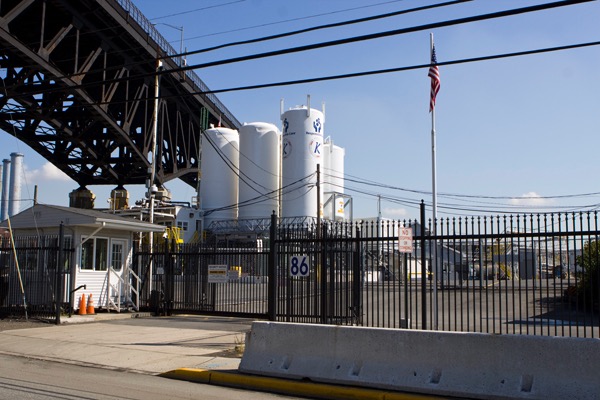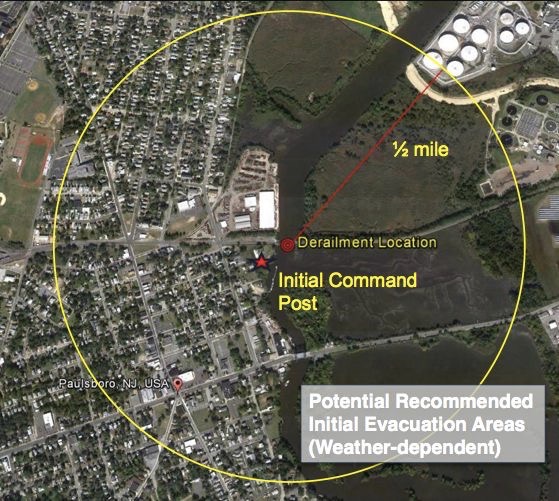From Bhopal To Beirut To Paulsboro: Passaic Chemical Fire Shows It Can Happen Here
Legislature Urged To Conduct Oversight And Enact Reforms
More than 217 people were killed and 7,000 injured when 2,750 tons of ammonium nitrate exploded in Beirut’s port on 4 August 2020. The blast displaced 300,000 people and caused widespread destruction and devastation, damaging buildings up to 20km away. ~~~ Lebanon: One year on from devastating Beirut explosion, authorities shamelessly obstruct justice
The following is literally insane:
In places in NJ, it is illegal to smoke a cigarette within 100 feet of a school or playground.
- But you can store millions of pounds of “extraordinarily hazardous”, toxic, flammable and/or explosive chemicals literally next door to a school with minimal restrictions.
DEP regulations prohibit idling your car for more than 3 minutes to “protect the lungs of our children”.
- But you can operate a chemical plant or petroleum refinery that emits millions of pounds of toxic and carcinogenic chemicals into the air literally next door to a school with minimal restrictions.
You can’t get State and local permits to open a bicycle shop, bookstore, art gallery, Internet cafe, food co-op or affordable housing in an old industrial building without making massive investments in fire and other common sense safety measures, like sprinklers, smoke alarms, CO detectors, and fire prevention and suppression systems.
- But you can store millions of pounds of hugely flammable and explosive chemicals in old industrial buildings – firetraps with wooden floors and roofs – with minimal restrictions.
When Beirut blew up a little over a year ago, killing more than 217 people, Americans ignored or dismissed that catastrophe as the consequence of *backwards and corrupt Middle Eastern governments: what government would ever allow millions of pounds of highly explosive material to be stored in a densely populated city?
“The Beirut blast, one of the largest non-nuclear explosions in history, inflicted widespread devastation and caused immense suffering. Lebanese authorities promised a swift investigation; instead they have brazenly blocked and stalled justice at every turn, despite a tireless campaign for justice and criminal accountability by survivors and families of victims,” said Lynn Maalouf, Deputy Director for the Middle East and North Africa at Amnesty International.
“The Lebanese government tragically failed to protect the lives of its people, just as it has failed for so long to protect basic socio-economic rights. In blocking the judge’s attempts to summon political officials, the authorities have struck yet another blow to the people of Lebanon. Given the scale of this tragedy, it is astounding to see how far the Lebanese authorities are prepared to go to shield themselves from scrutiny.”
[* The late scholar Edward Said dismisses such ignorant arrogance:
There has been so massive and calculatedly aggressive an attack on contemporary Arab and Muslim societies for their backwardness, lack of democracy, and abrogation of women’s rights that we simply forget that such notions as modernity, enlightenment, and democracy are by no means simple and agreed-upon concepts that one either does or does not find like Easter eggs in the living-room. […
Reflection, debate, rational argument and moral principle based on a secular notion that human beings must create their own history have been replaced by abstract ideas that celebrate American or western exceptionalism, denigrate the relevance of context, and regard other cultures with contempt. ]
But even larger deadly catastrophes can happen right here in NJ, see:
And we almost just saw one in the Passaic, NJ chemical fire.
And just like Beirut officials resisted and covered up investigation and accountability, so too does that happen right here in NJ.
The resistance and corruption of State and local officials is compounded in NJ by the power of corporate interests, like the NJ Chemistry Council, the NJ Petroleum Council, and Big Pharma who repeatedly have blocked reforms (e.g. see below discussion of how they killed the bill to eliminate the $50 million liability cap. Those same corporate interests have blocked laws and DEP regulations to mandate reduction of greenhouse gas emissions).
For example, very few people are aware that the National Transportation Safety Board (NTSB) conducted an investigation into the toxic train derailment that forced evacuation of Paulsboro NJ. For a link to the NTSB Report and excerpts of many critical findings, see:
The NTSB made several highly critical findings about the performance of State and local agencies, yet that NTSB Report was virtually ignored by NJ media, Legislative policymakers, and regulatory agencies like NJ DEP. NTSB found:
About 7:30 a.m., police radio transmissions suggested that the vapor cloud was “nontoxic.” The police then changed the evacuation orders from mandatory evacuation to shelter-in-place. The police department did not become aware that vinyl chloride had been released until 8:30 a.m., just before the first incident command briefing. The situation was further confused when, at 10:30 a.m., the NJDEP publically (sic) announced that the hazard had dissipated. Therefore, the community protective measures were based on incorrect information about the released material.
… The NTSB concludes that the dissemination of inaccurate public information about the release of vinyl chloride revealed the lack of an effective system for communicating to the public accurate information about the current situation following the accident. (@ page 41)
These statistics indicate that many communities in the state still do not have NJSP-OEM-approved EOPs and that these communities are likely unprepared for emergencies that could occur in their jurisdictions, as was the Paulsboro community. This problem is amplified by New Jersey home rule laws that keep authority for managing an incident at the lowest local government level, thus discouraging regional and state authorities from intervening in an incident, even when faced with obvious response deficiencies.
… The NTSB concludes that had the borough of Paulsboro [or NJ OEM] performed an assessment of the emergency response needs and capabilities for the hazardous materials that are present and transiting through its community, it would have been apparent that the emergency response capabilities and plans were inadequate for the types of high consequence incidents that can occur in the jurisdiction. (@ p.51-52)
Fact-based decisions regarding the community exposure did not occur until the unified command was established at 1:00 p.m., when the federal on-scene coordinator directed more information to be gathered about community exposures. (@ p.42)
Like many small fire departments throughout the country, the Paulsboro Fire Department was unprepared for large-scale hazardous material emergency responses. The frequency of hazardous materials train traffic through the borough would have suggested a higher level of awareness and preparedness. The firefighters need to understand how to respond to incidents involving such hazards and advise the community on whether to evacuate or shelter in place if a release does occur. (@p.47)
The NTSB concludes that the New Jersey firefighter certification and training requirements were not effective as demonstrated by the failure of emergency responders to conduct operations in accordance with established health and safety protocols and OSHA HAZWOPER standards, and their lack of familiarity with available tools to evaluate toxic exposure threats. (@p.46)
That must not be allowed to happen again.
To try to stimulate the oversight, accountability and legislative and regulatory reforms to improve chemical safety in NJ, I fired off the letter below to Senate Environment Committee Chairman Bob Smith.
At the outset, I reminded Smith that he Chaired an Assembly Committee that held oversight hearings on the 1995 Knapp Technologies explosion in Lodi, NJ that killed 4 workers (full disclosure: I testified at that hearing and focused on the Whitman RTK and later broke the story on the TCPA rollbacks):
Dear Chairman Smith:
I am writing to urge that you direct an independent investigation, conduct open public legislative oversight hearings, and sponsor much needed legislative reforms to strengthen chemical safety and emergency response management planning and regulation, as recently exposed by the chemical fire in Passaic NJ.
As you will recall, as Chairman of an Assembly Committee, you held oversight hearings in the wake of the 1995 Knapp Technologies explosion in Lodi, NJ that killed 4 workers and put the community and emergency responders at risk.
Since then there have been a number of related incidents that strongly suggest the need for strengthening NJ’s chemical safety programs, including the toxic train derailment that forced evacuation of the community in Paulsboro, NJ.
As you know, the National Transportation Safety Board (NTSB) conducted an investigation into the Paulsboro incident and issued a Report that found significant deficiencies in NJ’s State and local programs.
Unfortunately, the NTSB Report was largely ignored and necessary reforms were not adopted.
In light of those NTSB findings and the recent chemical fire in Passaic, I suggest you focus attention on the following issues: (not an exhaustive list)
I) Unacceptable Risk Standard and Siting Restrictions, Phase Outs, And Bans
Under the federal Clean Air Act Section 112 Risk Management Planning (RMP) and NJ’s State Toxic Catastrophe Prevention Act (TCPA), certain facilities are required to conduct worst case “off site consequence” analysis, including mapping of “kill zones” where nearby people might be killed by a catastrophic release or accident.
Facilities that use and store similarly hazardous chemicals and pose similar risks are not subject to these TCPA requirements under the NJ Worker and Community Right to Know Act (RTK).
Legislative reforms should: 1) expand TCPA to RTK facilities above a certain risk threshold and mandate those analyses more broadly, 2) require that the results of these analyses be disclosed publicly, and 3) set siting standards as to what would constitute an “unacceptable risk” and unacceptable locations that would force shut down of operations.
II) Stronger State Standards and Oversight – Rescind Local Delegations
Please see the NTSB Report findings for deficiencies and suggested reforms.
“This problem is amplified by New Jersey home rule laws that keep authority for managing an incident at the lowest local government level, thus discouraging regional and state authorities from intervening in an incident, even when faced with obvious response deficiencies.”
III) Expansion of TCPA Protections Into RTK Program
(see above)
IV) Public Disclosure Of “Kill Zone” Risk Maps
(see above)
V) Immediate Incident Response Command Center And Real Time Disclosure Of All Monitoring Data
DEP should be required to immediately – or no later than 30 minutes after discovery – establish an incident command on scene.
DEP also should be required to create a website and disclose all monitoring data, in real time.
VI) Eliminate The Spill Act $50 Million Cap On Liability
In the wake of the Gulf of Mexico BP oil well blowout, I recall that you sponsored legislation to eliminate the current $50 million liability cap in NJ Spill Act. see:
I understand that that legislation was never adopted, see:
That liability cap is obviously inadequate, as the risks exposed in Paulsboro and Passaic illustrate.
VII) Additional Training, Certification, And State Oversight
(see NTSB Report findings)
VIII) Eliminate Current Law Protections Of Trade Secrets
Current law establishes trade secret protections and criminal penalties for disclosure of trade secrets.
The public has no idea about how broadly these laws apply and what information is being kept secret.
It is likely that these secrecy protections are being abused. They should be strictly narrowed or abolished.
***IX) Close the Gaping Loopholes In The Environmental Justice Law
The EJ law does not apply to DEP reviews and regulations under the Toxic Catastrophe Prevention Act (TCPA), the Worker and Community Right to Know Act (RTK) and State remediation law regarding cleanup, redevelopment, and NRD compensation and/or restoration of contaminated sites.
These loopholes must be closed.
I am available to disuse this recommendations or provide additional supporting material.
Respectfully,







